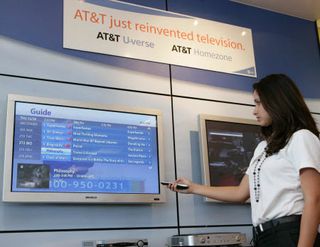AT&T U-verse Phase-Out Could Help Charter

AT&T’s plans to phase out its U-verse TV service in favor of satellite giant DirecTV makes sense on the surface, as the move allows the telco to take full advantage of the larger distributor’s cheaper programming deals. It also could open a window of opportunity for some cable competitors, according to analysts.
AT&T has indicated that satellite TV will become its primary traditional pay TV offering by the end of the first quarter of 2016, according to Sanford Bernstein analyst Paul de Sa. The move will allow the company to take better advantage of DirecTV’s programming contracts, de Sa said — the satellite service has 19 million customers vs. 6 million for U-verse.
It also potentially frees up 20 megabits per second of wireline capacity that could be used for broadband service. While some U-verse TV subscribers probably won’t switch to DirecTV, the company thinks that number will be negligible.
AN OPENING FOR CHARTER
Not de Sa though. In a report, the Sanford Bernstein analyst mapped out what he thinks could be a golden opportunity for Charter Communications, which has a largely rural footprint and the greatest exposure to U-verse TV at 29%. While Charter is expected to complete its merger with Time Warner Cable by the end of the first quarter, which would reduce its U-verse exposure to about 26% of homes passed, the analyst believes the opportunity is still there.
De Sa noted that Charter also is susceptible to the more aggressive DirecTV promotional activity that is expected as AT&T transitions away from U-verse TV. But he believes at least for the short term, the tradeoff is to Charter’s advantage.
De Sa thinks that de-emphasizing U-verse TV will ease the competitive pressure in those markets — reducing video competition from four providers to three — and he believes a “material number of subscribers will shift to cable rather than take a DirecTVbased bundle.”
Multichannel Newsletter
The smarter way to stay on top of the multichannel video marketplace. Sign up below.
While AT&T could aggressively discount DirecTV service in its U-verse TV territories to make its package more palatable to consumers, de Sa believes that won’t happen for at least the next 12 to 18 months, as AT&T concentrates on post-merger integration, deploying its planned unified satellite/managed IP platform and neutralizing overall content costs.
“We are inclined to think that the opportunity for cable outweighs the risks,” de Sa wrote.
Pivotal Research Group CEO and senior media & communications analyst Jeff Wlodarczak wasn’t too convinced that AT&T would scrap U-verse TV, but he did see an opportunity for cable to assert its best-in-class broadband chops.
“Cable is all about leveraging their best in class fixed broadband,” Wlodarczak said. “AT&T is relying on inferior technology to try to leave more bandwidth to increase their U-verse DSL speeds. Cable should inevitably take back the vast majority of DSL subs.”
Telsey Advisory Group media analyst Tom Eagan added that moving U-verse TV subscribers to DirecTV will free up more capacity for broadband, which could make the product more compelling, rather than less.
“I’m not sure necessarily that Charter is going to win out on that because it has the largest satellite exposure,” Eagan said. “Anything that enhances DirecTV’s competitive market share isn’t necessarily a good thing for Charter.
“At the same time, AT&T also is aggressively marketing its wireless service, last week unveiling an offer that gives new and existing AT&T wireless customers who have or add DirecTV or U-verse TV unlimited video streaming, data talk and text for $180 per month. Couple that with up to $500 in discounts for DirecTV customers who are not current AT&T wireless subscribers to add that service, and the phone giant appears to be laying the groundwork for an aggressive quad play.
Eagan said the wireless moves could be a test of the viability of the quad play of voice, video, data and wireless, which up to now has fallen flat in the U.S. market.
MAKING A QUAD PLAY
In the past year, however, several cable operators have hinted at future wireless products including Comcast, which in October activated its mobile virtual network operator (MVNO) agreement with Verizon Wireless.
Eagan said that while the quad play has had more success in Europe — Virgin Media and Liberty Global have made inroads with their respective wireless offerings — in the U.S. it could have more value as a retention tool. He added that Virgin Media offered free cellular minutes to subscribers who took all four products.
“It was a low-cost way to combine the various services,” Eagan said. “What we saw was that the lowest churn of any customer anywhere was the quad-play customer.”
SIDEBAR: The U-Verse Multiverse
Cable operators could see a window of opportunity open as AT&T transitions its pay TV customers to DirecTV. And the operators with the biggest exposure to the service could have the biggest chance to benefit.
MSO % of Total Footprint
Charter. . . . . . . . . . . . . . . . . . . . . . 29%
Time Warner Cable . . . . . . . . . . . .26%
Comcast . . . . . . . . . . . . . . . . . . . . 26%
Cox . . . . . . . . . . . . . . . . . . . . . . . . .21%










